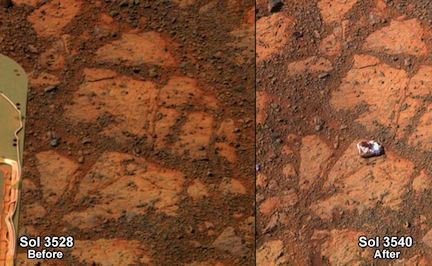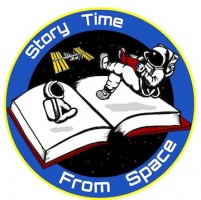As usual since I don’t post these very often, there’s a lot of news! I’ll only be able to cover a few highlights, but hope you find it useful. Contents:
- The Latest from Mars – A Jelly Donut?
- First Soft Moon Landing of Millennium — Chinese Rover
- Story Time From Space — Books Now In Orbit
- Gravity — Understanding Its Role In the Movie
- Has Global Warming Stopped?
- Upcoming Events: CCIRA, Boulder Bookstore, USA Science Festival
- Northern Lights Tours
- And more…
The Latest from Mars – A Jelly Donut?
The Mars Opportunity rover, originally designed to explore Mars for just 3 months, just passed its 10 year anniversary on Mars. Pretty amazing… And it also turned up one of its coolest photo pairs yet. In case you haven’t already seen it, check out this pair of photos taken about 12 days apart in the same spot:

Notice that a rock has appeared in the second photo, and because of its color and shape it has been nicknamed the “jelly donut.” How can a rock suddenly appear like this on Mars? Well, it’s probably not due to Martians playing a joke on us, and the most likely explanation is that it was kicked up by the rover’s wheels during the 12-day period. Still, a nice mini-mystery for the scientists to solve.
In other Martian news:
- The Curiosity rover has now passed 17 months on Mars and continues its journey toward Mt. Sharp. Visit the Curiosity web site for the latest news and photos.
- The next NASA mission to Mars, called the Mars Atmosphere and Volatile Evolution Mission (MAVEN), launched successfully on November 18 and will enter Martian orbit in September. Read this prior post to learn more about it.
- MAVEN was not the only orbiter launched toward Mars in November. Two weeks earlier, India launched its first Mars mission, called the Mars Orbiter Mission (MOM). Clearly, space is becoming an ever-more international endeavor.
Question for Class: The photos above are labeled in “Sols” rather than “days.” Can you find out why, and how a Sol is different from a “day”? (Answer: A Sol is a Martian day, which is a little longer than an Earth day because Mars takes a little longer to rotate. In fact, the rotation periods of Mars and Earth are remarkably similar: A Martian day (Sol) is only about 40 minutes longer than our 24-hour Earth day.)
Class Project: A great project for K-12 students is to create a “Mars journal”for one of the rovers. The level of sophistication can vary with age. For younger kids, they might just compile cool photos. For older kids, have them also pretend to write a journal from the rover’s point of view, including as much detail as is appropriate to their grade level.
First Soft Moon Landing of Millennium — Chinese Rover
For the first time since 1976, there was a soft landing on the Moon — and it’s a Chinese rover. Readers of my books (especially Max Goes to the Moon) will know that I feel strongly that space exploration should be an international endeavor. For a quick overview of why, please see my post from the 40th anniversary of the Apollo 11 Moon landing. And for teachers, here are a few suggested discussion topics:
- Research China’s space program and learn about Chinese plans for future lunar exploration. Do you think the Chinese will land people on the Moon before Americans return to the Moon?
- Take a position on the question of whether we should join the Chinese and other countries in making lunar exploration an international endeavor. Defend your opinion.
- People like me argue that space exploration has great value to our economy. Try the following numbers to see why: Suppose that the inspiration from a lunar or Mars exploration program inspires 1% more of Americans (which is about 3 million people) to go to college than would otherwise go. College graduates on average (median) earn $28,000 more per year than high school graduates, which translates to about $1.1 million more in a 40-year career. So what’s the total value to the economy if this increased college enrollment really happens? Do you think it will? Hold a debate on the topic of whether space exploration is economically beneficial. (Answer to numerical part: If the given assumptions hold true, the economic benefit is 3 million people x $1.1 million more earnings per person, or more than $3 trillion in total.)
Story Time From Space — Books Now In Orbit
I can hardly believe it, but my five children’s books are now orbiting Earth, having been launched January 9 on the Orbital 1 rocket. The videos of the astronaut readings should start coming down soon – and it looks like we may get readings in Japanese (by Japanese astronaut Koichi Wakata) and in Russian (by the cosmonauts onboard) as well. All the videos (and translations) will be posted freely on the web. I hope you’ll take time to learn more about the program, especially if you are a teacher. Here two key resources that should help:
- The Story Time From Space Facebook page. Please “like” it!
- Astronaut Alvin Drew discussing the program on Space Station Live. Note: Alvin helped start the Story Time From Space program and piloted it in 2011 on the final mission of the Space Shuttle Discovery. (And yes, this is the same Alvin Drew who you see in a fantastic Air Force commercial for TV and movie theaters.)
Note: While NASA and CASIS are supporting the Story Time From Space project with the launch opportunity and the involvement of astronauts, the current budget situation means that they do not have funds available to support the associated curriculum development and other educational components of the program. Story Time From Space leader Patricia Tribe is therefore seeking private funding sources to support the program; if you are able to help or have ideas about how to help, please contact her directly: patricia.tribe@gmail.com.
Gravity — Understanding Its Role In the Movie
The movie Gravity is well worth seeing, but a lot of people don’t realize the true role of gravity in the movie. The problem is that many people mistakenly believe that there’s “no gravity in space” — which is absolutely false! I’ve written a post about it; teachers should read this version that includes activities and resources.
Has Global Warming Stopped?
You’ve probably heard folks in the media claiming that “global warming has stopped” over the past 15 years. Are they right? Talking about it won’t tell us, but looking at the data will. I’ve compiled and analyzed some of the data in this short post; please have a look…
Upcoming Events: CCIRA, Boulder Bookstore, USA Science Festival
I’ll be at three upcoming events, and hope some of you can join me at them:
- For Colorado Area Teachers: If you are attending CCIRA (Feb. 6-7), please come visit the Big Kid Science/Story Time From Space table in the exhibits area. I will be there Thursday and Friday afternoons; on Friday, I’ll be joined by astronaut Alvin Drew.
- For everyone in the Boulder/Denver Area: I hope you can come to the Boulder Bookstore on Thursday, March 13, 7pm. I will be doing a short presentation and signing of What is Relativity?.

- For those in the DC area: The USA Science and Engineering Festival is a great event for everyone, including kids, parents, and teachers. I’ll be there with the CASIS booth and the Story Time From Space team, and will have presentations on Saturday April 26 at 9:30am and 3pm in the CASIS presentation room, and at 1:30pm on the book stage.
Northern Lights Tours
My family and I took a wonderful trip to Iceland last year to see the Northern Lights. I highly recommend taking such a trip, particularly this year or next when solar activity is expected to remain relatively high (we are near the peak of the typically 11-year sunspot cycle). If you are looking for an organized tour, I recommend Doug Duncan’s Northern Lights trips. Note that space is very limited!
And more…
I add additional posts from time to time, so please keep checking this blog for recent posts to see what is new. Thanks so much!

